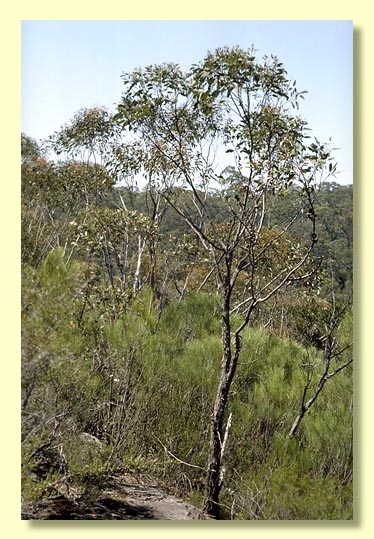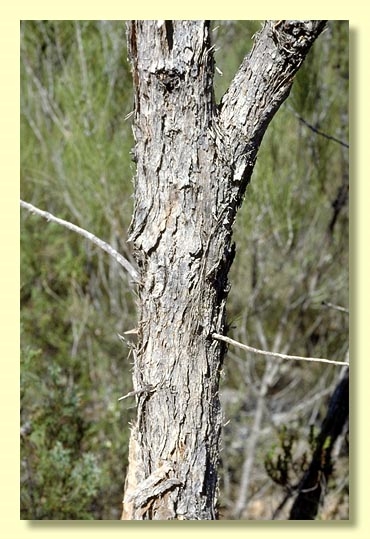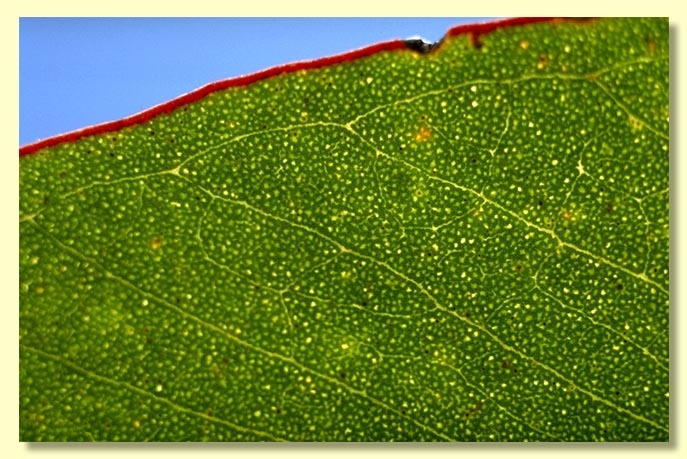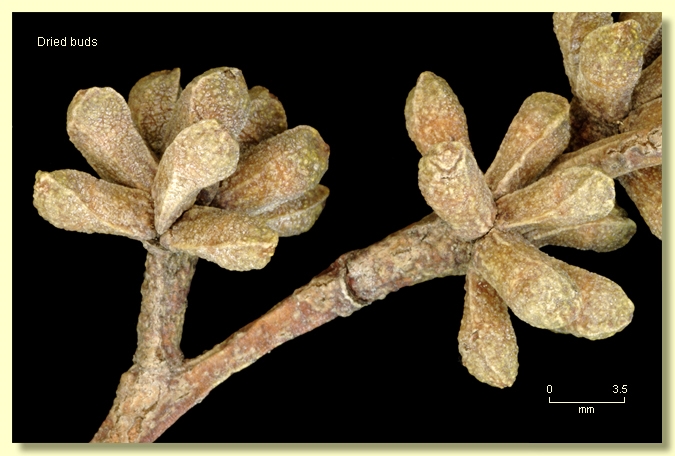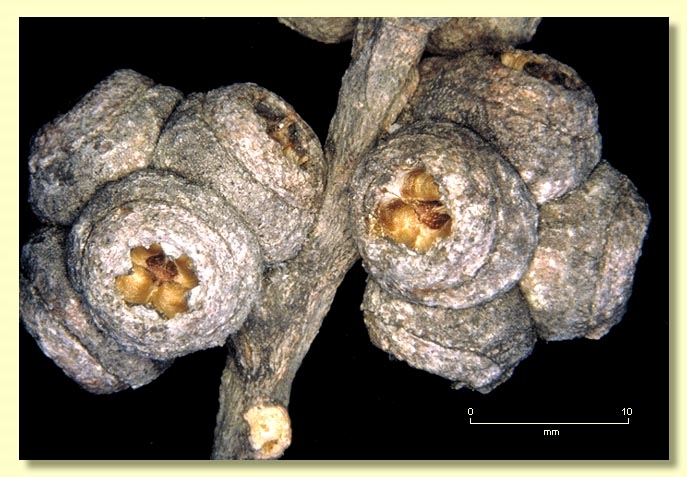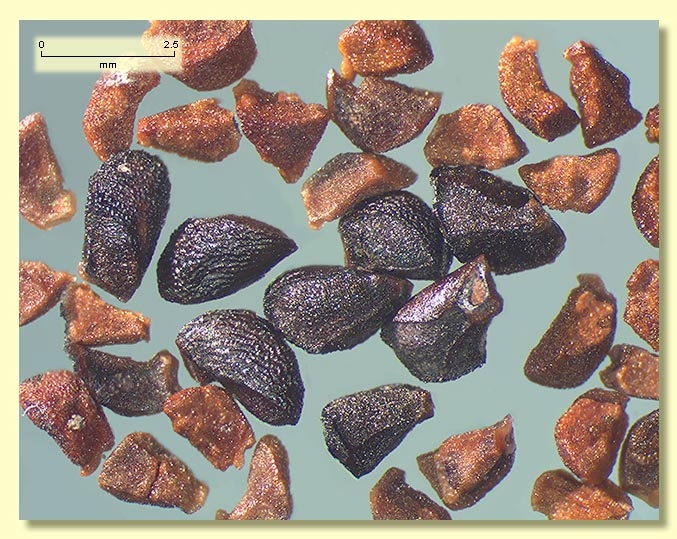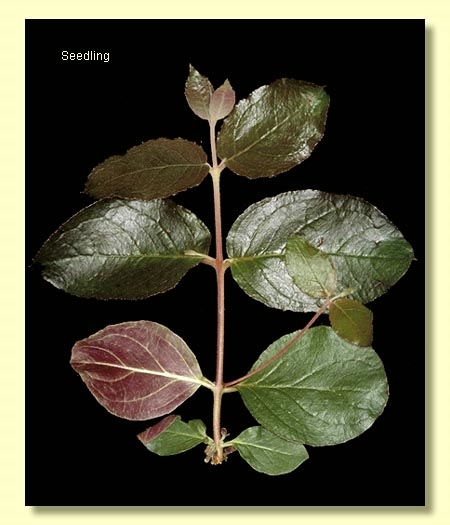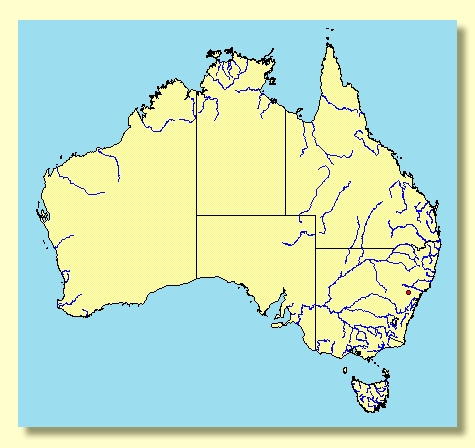Euclid - Online edition
Eucalyptus bensonii
Eucalyptus | Eucalyptus | Capillulus | Pachyphloius
Bark rough on part or all of trunk and branches to 6 cm diameter, stringy, grey or brown, branches smooth above.
Juvenile growth (coppice or field seedlings to 50 cm): stem rounded in cross-section, scabrid; juvenile leaves always petiolate (petioles 0.5–0.7 cm), alternate, broadly ovate rarely elliptical, 4–7 cm long, 3–4 cm wide, leaf-bases rounded, discolorous, glossy above, green; new growth tips, stems and at least the undersides of leaves scabrid with the remains of stellate hairs for at least 1 m in height of coppice.
Adult leaves alternate, petiole 1–2 cm long; blade broadly lanceolate to falcate, 6–12 cm long, 1.9–3.7 cm wide, base oblique or tapering to petiole, concolorous, glossy, green, side-veins at an acute or wider angle to midrib, reticulation obscure or sparse, intramarginal vein parallel to and well removed from margin, oil glands island.
Inflorescence axillary unbranched, peduncles 0.4–1.2 cm long, buds in umbels of 7, 9 or ?11 per umbel, sessile. Mature buds oblong, 0.5–1 cm long, 0.3–0.4 cm wide, warty, scar absent, operculum conical to rounded, stamens irregularly flexed, anthers reniform to cordate, versatile, dorsifixed, dehiscing by confluent slits, style long, stigma tapered, locules 3 or 4, the placentae each with 2 vertical ovule rows. Flowers white.
Fruit sessile, cup-shaped, hemispherical or truncate-globose, 0.5–0.7 cm long, 0.8–1.2 cm wide, clustered together but not compressed laterally, disc weakly to strongly raised-convex, valves 3 or 4, near rim level.
Seeds brown, 1.6–2.2 mm long, pyramidal or obliquely pyramidal, dorsal surface smooth, hilum terminal.
Cultivated seedlings (measured at ca node 10): cotyledons reniform; stems rounded in cross-section, stellate-hairy; leaves opposite for at least 7 nodes, petiolate, ovate to broadly so, 5–8 cm long, 4–5.5 cm wide, base truncate to rounded, margin irregular, discolorous, glossy, green above, sparsely to moderately stellate-hairy.
Flowering has been recorded in January and November.
A mallee or stunted stringybark tree of very restricted distribution in mountains of Wollemi National Park south-east of Rylstone in New South Wales, occurring in discontinuous woodlands on ridge tops and plateaus on shallow sandstone-derived soils. Eucalyptus bensonii has rather coarse broad glossy green adult and ovate juvenile leaves scabrid on the underside, squat sessile buds with rounded to conical operculum and flattened fruit.
E. bensonii is only likely to be confused with other stringybark species; those growing in the general area are E. sparsifolia and E. tenella, which differ in having narrower juvenile and adult leaves, and smaller fusiform buds and smaller fruit. Further to the west another stringybark occurs, E. macrorhyncha subsp. cannonii, which has beaked buds and fruit with very prominently raised disc and exserted valves.
Eucalyptus bensonii is considered a close relative of E. camfieldii, a species endemic to the Sydney metropolitan area, which differs in having rounded to heart-shaped, mucronate juvenile leaves and shorter, stubby buds and (usually) smaller fruit.
MORE ABOUT STRINGYBARKS

